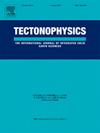断层阶跃中强地面运动(> 1 g)的破裂动力学建模
IF 2.7
3区 地球科学
Q2 GEOCHEMISTRY & GEOPHYSICS
引用次数: 0
摘要
在2019年7月加利福尼亚州里奇克莱斯特地震之后,多名现场调查人员注意到,沿着右侧走滑M7.1破裂痕迹,鹅卵石到巨石大小的岩石已经从它们在沙漠路面上的位置移动,没有拖拽或剪切的证据。这意味着局部地面运动超过1g,而仪器记录的峰值为0.57 g。在2010年以走滑为主的7.2级El Mayor-Cucapah地震中,也发生了类似的岩石位移。总之,这些例子表明,地震破裂如何协调走滑断层的某些方面产生了极其局部的强地面加速度。在这里,我们使用三维有限元方法来研究通过各种走滑阶梯几何形状的破裂如何影响强地面加速度。对于亚剪切破裂,我们发现台阶的存在通常比它的尺寸更重要;最强的地面加速度总是发生在第一个断层的末端。对于超剪切破裂,阶梯效应实际上是无关紧要的,因为最强的粒子加速度发生在第一个断层上的超剪切过渡点。我们的模型亚剪切和超剪切破裂同样会产生超过1g的水平粒子加速度,但在离断层如此近的区域(<;1公里),地震台网可能捕捉不到。我们认为,通过断层台阶的物理破裂可能是导致里奇克莱斯特地震和埃尔马约尔-库卡帕地震中移位岩石的原因,并且台阶地区可能具有特别高的地面运动危险。我们的研究表明,地面运动预测和局部危险评估应该考虑到活动断层的近场更强的加速度,特别是在台阶和其他几何不连续的周围。本文章由计算机程序翻译,如有差异,请以英文原文为准。
Modeling the rupture dynamics of strong ground motion (> 1 g) in fault stepovers
Following the July 2019 Ridgecrest, California earthquakes, multiple field investigators noted that pebble- to boulder-sized rocks had been displaced from their position in the desert pavement within a stepover along the right-lateral strike-slip M7.1 rupture trace, without evidence of dragging or shearing. This implies localized ground motions in excess of 1 g, in contrast to the instrumentally recorded peak of 0.57 g. Similar rock displacement occurred in a stepover in the predominantly strike-slip 2010 M7.2 El Mayor-Cucapah earthquake. Together, these examples suggest that some aspect of how earthquake rupture negotiates a strike-slip fault stepover produces extremely localized strong ground acceleration. Here, we use the 3D finite element method to investigate how rupture through a variety of strike-slip stepover geometries influences strong ground acceleration. For subshear ruptures, we find that the presence of a stepover in general matters more than its dimensions; the strongest ground acceleration always occurs at the end of the first fault. For supershear ruptures, the stepover is effectively irrelevant, since the strongest particle acceleration occurs at the point of the supershear transition on the first fault. Our model subshear and supershear ruptures alike do produce horizontal particle acceleration above 1 g, but over a region so close to the fault (< 1 km) that a seismic network may not catch it. We suggest that the physics of rupture through a fault stepover could have been responsible for the displaced rocks in the Ridgecrest and El Mayor-Cucapah earthquakes, and that stepover regions may have particularly high ground motion hazard. Our study suggests that ground motion predictions and local hazard assessments should account for much stronger accelerations in the immediate near field of active faults, especially around stepovers and other geometrical discontinuities.
求助全文
通过发布文献求助,成功后即可免费获取论文全文。
去求助
来源期刊

Tectonophysics
地学-地球化学与地球物理
CiteScore
4.90
自引率
6.90%
发文量
300
审稿时长
6 months
期刊介绍:
The prime focus of Tectonophysics will be high-impact original research and reviews in the fields of kinematics, structure, composition, and dynamics of the solid arth at all scales. Tectonophysics particularly encourages submission of papers based on the integration of a multitude of geophysical, geological, geochemical, geodynamic, and geotectonic methods
 求助内容:
求助内容: 应助结果提醒方式:
应助结果提醒方式:


